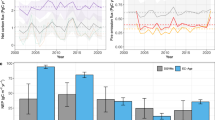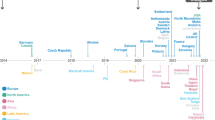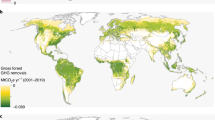Abstract
Achieving the long-term temperature goal of the Paris Agreement requires forest-based mitigation. Collective progress towards this goal will be assessed by the Paris Agreement’s Global stocktake. At present, there is a discrepancy of about 4 GtCO2 yr−1 in global anthropogenic net land-use emissions between global models (reflected in IPCC assessment reports) and aggregated national GHG inventories (under the UNFCCC). We show that a substantial part of this discrepancy (about 3.2 GtCO2 yr−1) can be explained by conceptual differences in anthropogenic forest sink estimation, related to the representation of environmental change impacts and the areas considered as managed. For a more credible tracking of collective progress under the Global stocktake, these conceptual differences between models and inventories need to be reconciled. We implement a new method of disaggregation of global land model results that allows greater comparability with GHG inventories. This provides a deeper understanding of model–inventory differences, allowing more transparent analysis of forest-based mitigation and facilitating a more accurate Global stocktake.
This is a preview of subscription content, access via your institution
Access options
Access Nature and 54 other Nature Portfolio journals
Get Nature+, our best-value online-access subscription
$29.99 / 30 days
cancel any time
Subscribe to this journal
Receive 12 print issues and online access
$209.00 per year
only $17.42 per issue
Buy this article
- Purchase on SpringerLink
- Instant access to full article PDF
Prices may be subject to local taxes which are calculated during checkout





Similar content being viewed by others
Data availability
The data that support the findings of this study are available from the corresponding author upon request.
References
Adoption of the Paris Agreement FCCC/CP/2015/L.9/Rev.1 (UNFCCC, 2015).
Fuglestvedt, J. et al. Implications of possible interpretations of ‘greenhouse gas balance’ in the Paris Agreement. Phil. Trans. R. Soc. A 376, 20160445 (2018).
Rockström, J. et al. A roadmap for rapid decarbonization. Science 355, 1269–1271 (2017).
Houghton, R. A., Byers, B. & Nassikas, A. A. A role for tropical forests in stabilizing atmospheric CO2. Nat. Clim. Change 5, 1022–1023 (2015).
Grassi, G. et al. The key role of forests in meeting climate targets requires science for credible mitigation. Nat. Clim. Change 7, 220–226 (2017).
Griscom, B. W. et al. Natural climate solutions. Proc. Natl Acad. Sci. USA 114, 11645–11650 (2017).
Federici, S. et al. GHG Fluxes from Forests: An Assessment of National GHG Estimates and Independent Research in the Context of the Paris Agreement (Climate and Land Use Alliance, 2017).
Houghton, R. A. et al. Carbon emissions from land use and land-cover change. Biogeosciences 9, 5125–5142 (2012).
Houghton, R. A. & Nassikas, A. A. Global and regional fluxes of carbon from land use and land cover change 1850-2015. Glob. Biogeochem. Cycles 31, 456–472 (2017).
Le Quéré, C. et al. Global carbon budget 2017. Earth Syst. Sci. Data 10, 405–448 (2018).
IPCC 2006 IPCC Guidelines for National Greenhouse Gas Inventories (National Greenhouse Gas Inventories Programme, IGES, 2008).
IPCC Revisiting the Use of Managed Land as a Proxy for Estimating National Anthropogenic Emissions and Removals (eds Eggleston, S. et al.) (IGES, 2010).
Romijn, E. et al. Assessing change in national forest monitoring capacities of 99 tropical countries. For. Ecol. Manage. 352, 109–123 (2015).
Ogle, S. M. et al. Delineating managed land for reporting national greenhouse gas emissions and removals to the United Nations framework convention on climate change. Carbon Balance Manag. 13, 9 (2018).
Grassi, G., Pilli, R., House, J., Federici, S. & Kurz, W. A. Science-based approach for credible accounting of mitigation in managed forests. Carbon Balance Manage. 13, 8 (2018).
Kurz, W. A. et al. Quantifying the impacts of human activities on reported greenhouse gas emissions and removals in Canada’s managed forest: conceptual framework and implementation. Can. J. For. Res. https://doi.org/10.1139/cjfr-2018-0176 (2018).
Canadell, J. G. et al. Factoring out natural and indirect human effects on terrestrial carbon sources and sinks. Environ. Sci. Policy 10, 370–384 (2007).
Pongratz, J., Reick, C. H., Houghton, R. A. & House, J. I. Terminology as a key uncertainty in net land use and land cover change carbon flux estimates. Earth Syst. Dynam. 5, 177–195 (2014).
Hansis, E., Davis, S. J. & Pongratz, J. Relevance of methodological choices for accounting of land use change carbon fluxes. Glob. Biogeochem. Cycles 29, 1230–1246 (2015).
Ciais P. et al. in Climate Change 2013: The Physical Science Basis (eds Stocker, T. F. et al.) Ch. 6 (IPCC, Cambridge Univ. Press, 2013).
Smith, P. et al. in Climate Change 2014: Mitigation of Climate Change (eds Edenhofer, O. et al.) Ch. 11 (IPCC, Cambridge Univ. Press, 2014)
Sitch, S. et al. Recent trends and drivers of regional sources and sinks of carbon dioxide. Biogeosciences 12, 653–679 (2015).
Erb, K.-H. et al. Bias in the attribution of forest carbon sinks. Nat. Clim. Change 3, 854–856 (2013).
Le Quéré, C. et al. Global Carbon Budget 2015. Earth Syst. Sci. Data 7, 349–396 (2015).
Keenan, T. F. et al. Recent pause in the growth rate of atmospheric CO2 due to enhanced terrestrial carbon uptake. Nat. Commun. 7, 13428 (2016).
Pretzsch, H., Biber, P., Schütze, G., Uhl, E. & Rötzer, T. Forest stand growth dynamics in Central Europe have accelerated since 1870. Nat. Commun. 5, 4967 (2014).
Allen, C. D. et al. A global overview of drought and heat-induced tree mortality reveals emerging climate change risks for forests. For. Ecol. Manage. 259, 660–684 (2010).
Pan, Y. et al. A large and persistent carbon sink in the world’s forests. Science 333, 988–993 (2011).
Federici, S., Tubiello, F. N., Salvatore, M., Jacobs, H. & Schmidhuber, J. New estimates of CO2 forest emissions and removals: 1990-2015. For. Ecol. Manage. 352, 89–98 (2015).
Mitchard, E. T. A. Review the tropical forest carbon cycle and climate change. Nature 559, 527–534 (2018).
Federici, S., Iversen, P., Lee, D. & Neeff, T. Analyzing National GHG Inventories of Forest Fluxes and Independent Estimates in the World’s Top Eight Forest Countries (Climate and Land Use Alliance, 2017).
FAOSTAT Land Use Emissions (FAO, 2015).
Baccini, A. et al. Tropical forests are a net carbon source based on aboveground measurements of gain and loss. Science 358, 230–234 (2017).
Yue, C. et al. Representing anthropogenic gross land use change, wood harvest and forest age dynamics in a global vegetation model ORCHIDEE-MICT (r4259). Geosci. Model Dev. Discuss. https://doi.org/10.5194/gmd-2017-118 (2017).
Arneth, A. et al. Historical carbon dioxide emissions caused by land-use changes are possibly larger than assumed. Nat. Geosci. 10, 79–84 (2017).
Riahi, K. et al. The Shared Socioeconomic Pathways and their energy, land use, and greenhouse gas emissions implications: an overview. Glob. Environ. Change 42, 153–168 (2017).
Rogelj, J., Hare, W., Chen, C. & Meinshausen, M. Discrepancies in historical emissions point to a wider 2020 gap between 2°C benchmarks and aggregated national mitigation pledges. Environ. Res. Lett. 6, 024002 (2011).
Rogelj, J. et al. Paris Agreement climate proposals need a boost to keep warming well below 2°C. Nature 534, 631–639 (2016).
Chapter Outline of the Working Group III Contribution to the IPCC Sixth Assessment Report (AR6) (IPCC, 2017).
Reick, C. H., Raddatz, T., Brovkin, V. & Gayler, V. Representation of natural and anthropogenic land cover change in MPI-ESM. J. Adv. Model. Earth Syst. 5, 459–482 (2013).
Oleson, K. W. et al. Technical Description of Version 4.5 of the Community Land Model (CLM) (National Center for Atmospheric Research, 2013).
Krinner, G. et al. A dynamic global vegetation model for studies of the coupled atmosphere-biosphere system. Glob. Biogeochem. Cycles 19, 1–33 (2005).
Zaehle, S. & Friend, A. D. Carbon and nitrogen cycle dynamics in the O-CN land surface model: 1. Model description, site-scale evaluation, and sensitivity to parameter estimates. Glob. Biogeochem. Cycles 24, 1–13 (2010).
Zaehle, S. et al. Carbon benefits of anthropogenic reactive nitrogen offset by nitrous oxide emissions. Nat. Geosci. 4, 601–605 (2011).
Kato, E., Kinoshita, T., Ito, A., Kawamiya, M. & Yamagata, Y. Evaluation of spatially explicit emission scenario of land-use change and biomass burning using a process-based biogeochemical model. J. Land Use Sci. 8, 104–122 (2013).
Clark, D. B. et al. The Joint UK Land Environment Simulator (JULES), model description – Part 2: Carbon fluxes and vegetation dynamics. Geosci. Model Dev. 4, 701–722 (2011).
Smith, B. et al. Implications of incorporating N cycling and N limitations on primary production in an individual-based dynamic vegetation model. Biogeosciences 11, 2027–2054 (2014).
Bondeau, A. et al. Modelling the role of agriculture for the 20th century global terrestrial carbon balance. Glob. Change Biol. 13, 679–706 (2007).
Jain, A. K., Meiyappan, P., Song, Y. & House, J. I. CO2 emissions from land-use change affected more by nitrogen cycle, than by the choice of land-cover data. Glob. Change Biol. 19, 2893–2906 (2013).
Peters, G. P. et al. Key indicators to track current progress and future ambition of the Paris Agreement. Nat. Clim. Change 7, 118–122 (2017).
The Emissions Gap Report 2017 (UNEP, 2017).
Schleussner, C.-F. et al. Science and policy characteristics of the Paris Agreement temperature goal. Nat. Clim. Change 6, 827–835 (2016).
APA Item 6: Matters Relating to the Global Stocktake Referred to in Article 14 of the Paris Agreement (UNFCCC, 2018).
Holz, C. & Ngwadla, X. The Global Stocktake Under the Paris Agreement (European Capacity Building Initiative, 2016).
Prasad, S., Ganesan, K. & Gupta, V. Shaping the Global Stocktake Process Under the Paris Agreement (CEEW, 2017).
Koven, C. D. et al. Permafrost carbon-climate feedbacks accelerate global warming. Proc. Natl Acad. Sci. USA 108, 14769–14774 (2011).
Cowie, A. L., Kirschbaum, M. U. F. & Ward, M. Options for including all lands in a future greenhouse gas accounting framework. Environ. Sci. Policy 10, 306–321 (2007).
Greenhouse Gas Inventories (UNFCCC, 2018); https://go.nature.com/2MG9sVB
Biennial Update Reports (UNFCCC, 2018); https://go.nature.com/2D3grIE
National Communications Non-Annex 1 (UNFCCC, 2018).
REDD+ Submission to UNFCCC (UNFCCC, 2018).
Houghton, R. A. et al. Changes in the carbon content of terrestrial biota and soils between 1860 and 1980: a net release of CO2 to the atmosphere. Ecol. Monogr. 53, 235–262 (1983).
Klein Goldewijk, K., Beusen, A., Van Drecht, G. & De Vos, M. The HYDE 3.1 spatially explicit database of human-induced global land-use change over the past 12,000 years. Glob. Ecol. Biogeogr. 20, 73–86 (2011).
Hurtt, G. C. et al. Harmonization of land-use scenarios for the period 1500–2100: 600 years of global gridded annual land-use transitions, wood harvest, and resulting secondary lands. Climatic Change 109, 117–161 (2011).
FAOSTAT (FAO, 2010).
Jones, P. W. & Jones, P. W. First- and second-order conservative remapping schemes for grids in spherical coordinates. Mon. Weather Rev. 127, 2204–2210 (1999).
Acknowledgements
The authors thank J. Pongratz for discussing an early stage of the analysis, V. Korotkov for checking our analysis on Russia, and G. M. Domke for checking our analysis on the United States. J.H. was supported by EU FP7 through project LUC4C (GA603542) and the UK NERC project GGRiLS-GAP. G.G. was supported by Administrative Arrangement Number 340203/2016/742550/SER/CLIMA.A3. A.K.J. was supported by the NSF (AGS 12-43071) and DOE (DE-SC0016323). J.E.M.S.N. was supported by the German Research Foundation’s Emmy Noether Programme (grant number PO1751/1-1). G.G., J.H., G.P.P. and L.P. received funding from the European Union’s Horizon 2020 research and innovation programme under grant agreement number 776810 (VERIFY). C.D.K. was supported by the US DOE under Contract DE-AC02-05CH11231 as part of their RGMA (BGC-Feedbacks SFA) and TES Programs (NGEE-Tropics). A.K.J. was supported under the US NSF (NSF-AGS-12-43071).
Author information
Authors and Affiliations
Contributions
G.G. designed the analysis with J.H. and W.A.K., and all three drafted the manuscript. G.G. coordinated all of the inputs, executed the calculations and made the figures. A.C., R.A.H., G.P.P. and M.J.S. contributed to the analysis and provided inputs to the manuscript. F.D. contributed by commenting and editing the manuscript. R.A.V., S.R., S.F. and D.L. contributed to collecting data and information on country GHGIs. R.A. post-processed the DGVM results. R.A.H. and A.A.N. provided data from bookkeeping models. L.P. provided comments on the Global stocktake. A.A., A.B., M.F., P.F., A.K.J., E.K., C.D.K., J.E.M.S.N., S.S., N.V., A.W. and S.Z. provided the original DGVM results and inputs to the manuscript. All authors read and approved the final manuscript.
Corresponding author
Ethics declarations
Competing interests
The authors declare no competing interests.
Additional information
Publisher’s note: Springer Nature remains neutral with regard to jurisdictional claims in published maps and institutional affiliations.
Supplementary information
Supplementary information
Supplementary methods and data 1–4, Supplementary analysis and results 5-8, Supplementary tables 1–12, Supplementary figures 1–9, Supplementary references
Rights and permissions
About this article
Cite this article
Grassi, G., House, J., Kurz, W.A. et al. Reconciling global-model estimates and country reporting of anthropogenic forest CO2 sinks. Nature Clim Change 8, 914–920 (2018). https://doi.org/10.1038/s41558-018-0283-x
Received:
Accepted:
Published:
Issue Date:
DOI: https://doi.org/10.1038/s41558-018-0283-x
This article is cited by
-
The ocean carbon sink enhances countries’ inclusive wealth and reduces the cost of national climate policies
Communications Earth & Environment (2024)
-
A unified modelling framework for projecting sectoral greenhouse gas emissions
Communications Earth & Environment (2024)
-
Future land carbon removals in China consistent with national inventory
Nature Communications (2024)
-
Growing biomass carbon stock in China driven by expansion and conservation of woody areas
Nature Geoscience (2024)
-
Mapping forest-based natural climate solutions
Communications Earth & Environment (2024)



